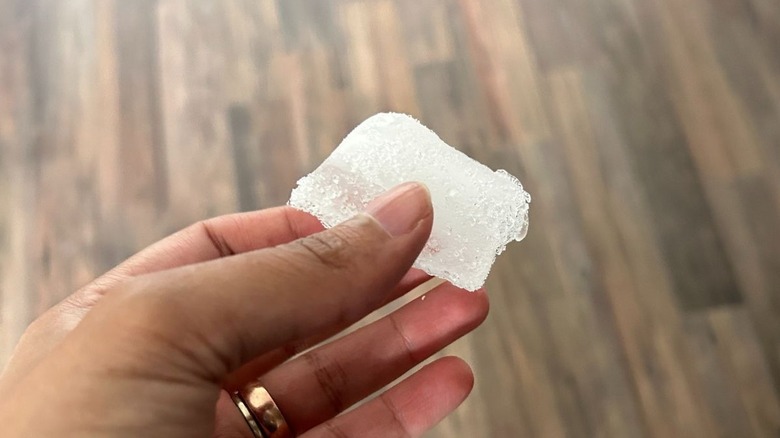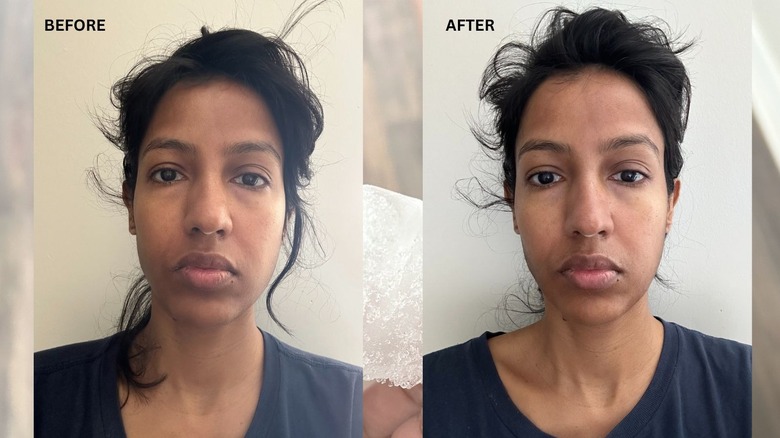We Tried The Facial Icing Trend To Melt Away Puffiness. Here's What Happened
Puffiness in my face is something I've dealt with for most of my adult life. Call it genetics or call it just plain bad luck, but I've rarely, if ever, woken up in the morning with a face that wasn't sort of bloated-looking, especially under my eyes. In fact, it's even become my signature look (one of the reasons why we tried using banana peels under our eyes, as well).
So when TikTok, Instagram, and YouTube started filling up with videos of something called a facial icing trend, it was only a matter of time before I wanted to try it. On previous occasions, I had put teaspoons in the fridge overnight to use them as cooling tools under my eyes when I woke up in the morning. And this seemed to work. So what's to be worried about when placing ice cubes on your face and massaging them against your skin?
To be clear, there seemed to be different versions of the facial icing trend on the internet. Some proponents were wrapping ice cubes in thin pieces of cloth or paper towels and moving the small block all over their faces. Others were straight up dunking their faces into ice-cold water, complete with ice cubes (Brr). Still more were using iced cucumbers on their undereyes to reduce puffiness. I went with the ice cubes wrapped in paper towels method — and I must admit, I saw a difference when it came to facial puffiness. Here's how it went.
The ice cubes reduced facial puffiness, but not by much
It is safe to say that I was expecting the hack to work. Like I said, I wasn't completely new to the concept of using ice-cold tools to reduce puffiness. I tried facial icing on two separate days. I made sure there was freshly placed water in an ice tray every night and went to bed knowing I had a home-made remedy for puffiness waiting for me come morning.
At dawn, I extracted the ice cubes, wrapped two in a paper towel, and gently applied the cool tool to my face, starting near my forehead and slowly making my way to my cheeks, nose, chin, jawline, and other areas. I applied gentle pressure and massaged my skin as I went around my face. I did this for about 1-2 minutes (recommended by proponents). Something about listening to music and giving yourself some self-love first thing in the morning, while looking at yourself in the mirror, was relaxing too.
After the exercise, I washed my face, dried it, and viewed the results. My skin not only looked a little less puffy (especially under my eyes and around the contours of my nose), but I also thought it looked more vibrant. Skincare experts recommend that you avoid applying the ice directly to your face (for fear of ice burn). And to keep your ice-covered cloth moving, again for the same reason. Some also recommend washing your face and moisturizing afterward to avoid dry skin. My results made me dig deeper into the science behind it all.
Facial icing works because of vasoconstriction
There isn't a whole lot of research behind the facial icing trend, per board-certified dermatologist Dr. Jeanine Downie (via Healthline). But this doesn't mean it doesn't work, especially in the context of reducing puffiness.
As explained by another board-certified dermatologist, Dr. Andrea Suarez, who goes by the name of Dr. Dray on YouTube, icing your face results in something called vasoconstriction, a narrowing of the blood vessels, which in turn can help reduce puffiness. "Especially puffiness around the eyes. The skin there is pretty thin to begin with, so it's going to feel the effects of that cooling temperature, and you're going to get vasoconstriction that may help push some of that fluid out of the tissues." This ties in with why we ice injuries.
What about the other surprising benefits of using ice on your face? Like acne reduction? Dermatologists are skeptical. For example, according to Dr. Downie, per Healthline, the less-inflamed look that comes with rubbing ice cubes on acne-prone skin (ice can bring down inflammation) is not permanent. While it may reduce swelling and soothe acne pain in the moment, your best course of defense would be to visit your dermatologist for the best way to treat painful acne. Also, find out what is really causing a puffy face in the morning. It could be anything from excessive salt intake to allergies. Don't try facial icing if you have sensitive skin, broken capillaries, or if you're just after any chemical procedures, cosmetic peels, or laser treatments.


